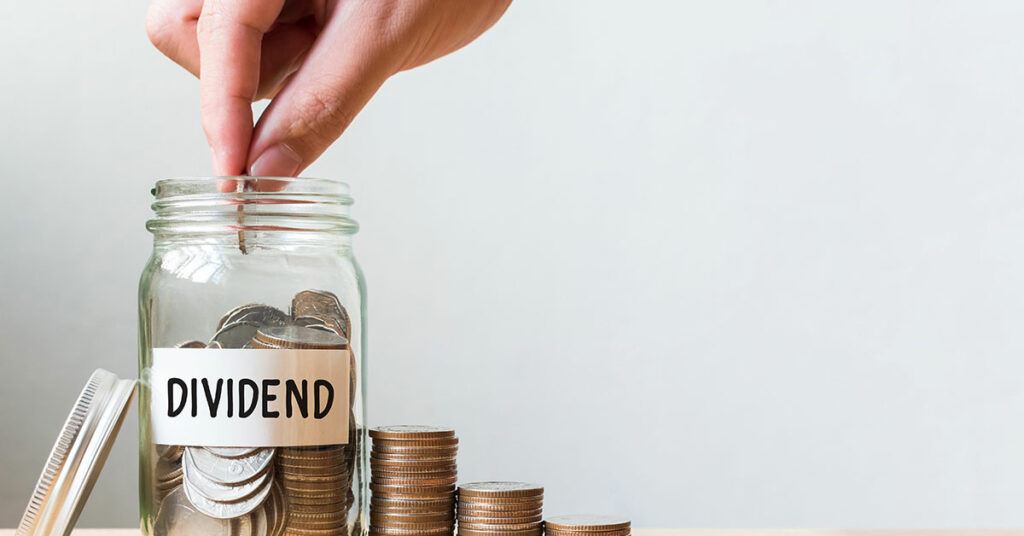What stocks have the best dividends?
What stocks have the best dividends and what is a dividend stock?
A dividend is a percentage of a company’s profits that the company pays to shareholders on a regular basis, typically quarterly. It is income that is investment gains in addition any potential increase in stock price. Dividend stocks are a good component of the investment portfolios of people who are of any age. Your portfolio may grow faster if you can determine what stocks have the best dividends.
There are several ways to evaluate dividend stocks . Here are some of the factors you can look at to find the best dividend stocks:
- Dividend yield – what the stocks pay out as a percentage of their price
- Payout ratios – what percent of their profits they pay out
- Dividend growth – whether the dividend rate has increased, decreased, or stayed the same over time
Older adults might rely on their dividend stocks to provide them with additional sources of income. Younger investors can reinvest the dividends that they receive so that their earnings can greatly increase.
Statistics on dividend stocks
From 1926 to 2015, income from dividend stocks accounted for one-third of the growth of the S&P 500. Researchers who looked at data from 1927 to 2014 found that dividend stocks had annual average growth rates of 10.4 percent as compared to 8.5 percent average annual growth of stocks that did not pay dividends.
These statistics demonstrate that having dividend-paying stocks is a good idea for any investor. You should consider adding dividend stocks to your diversified portfolio and reinvesting the dividends that you receive to accelerate your returns.

What things should investors look for in the best dividend stocks?
While it is a good idea to add dividend stocks to your portfolio, not all dividend stocks are created equally. The best dividend stocks are offered by companies that do not have substantial debt and that are growing and turning strong profits on a consistent basis.
Another consideration is to avoid companies that have cyclical profits and cash flow because they might not pay dividends during leaner times. They should also look at companies that have consistently paid dividends every year.
How to invest in dividend stocks
One common way that people can invest in a dividend stock is to purchase exchange-traded funds that hold stocks that pay dividends. To buy a dividend ETF, begin by searching for a well-diversified dividend ETF on your brokerage’s website. Make certain that the ETF is invested in stocks instead of bonds and purchase it.
The other primary method that people can invest and purchase the best dividend stocks is to do so individually. To do this, find a dividend stock and analyze it and the company. Decide how much of the stock that you want to buy, making certain that you keep your portfolio diversified.
Where to find dividend stocks
There are a number of places that you can look to find good dividend stocks. It is important that you look at the reasoning behind the recommendations that are given. Some examples of some resources that can provide you with a starting point in your search for the best dividend stocks include the following:
- FinViz
- Dividend.com
- Sure Dividend
- Brokerage accounts
- SEC data
- Specialty providers and paid services
- Stock exchanges
Look at the company
When you have identified a stock that pays dividends, it is important for you to carefully evaluate the company. You want to look for predictable dividend growth stocks. A healthy company that offers a dividend will have an ability for its payout to increase over time.
You want to avoid companies that have too much debt. You can look at a company’s debt to equity ratio and avoid companies that have ratios that are high. The company should also have a strong cash flow, consistent profits, and a high earnings expectation. Finally, you should take a look at the health of the industry in which the company is in.

Calculate the dividend payout ratio with the payout ratio formula
Calculating the dividend payout ratio is important. The payout ratio of a dividend stock is its dividend divided by the company’s earnings per share. The payout ratio of a dividend stock is the ratio of the dividend to the company’s profits. You will want to stay away from companies that have dividend payout ratios that are too high.
The earnings per share formula of a dividend stock is the difference between the company’s net income and the dividends that are paid for preferred stock divided by the average number of shares that are outstanding. You can find this information on a company’s financial statements that it files with the U.S. Securities and Exchange Commission on its company search page.
Total return
The total return of a dividend stock is a combination of the dividends that are paid and the share price appreciation. The formula for finding the total return of a dividend stock is as follows:
Total Stock Return= (P1 – P0 + D ) / P0
P0 = Initial price of the stock
P1 = Ending price of the stock for period one
D = Dividends
Earnings per share
You should next look at the company’s earnings per share. Consistent earnings growth is a good indication that a dividend stock is healthy and that the company will be able to continue growing its dividend. However, past performance is no guarantee of future results. You need to assess whether the reason for the increase in earnings is sustainable into the future. You can find this information on the financial statements that are filed with the Securities and Exchange Commission.
Price/earnings ratio
The P/E is a measure of a stock’s current price to its earnings per share. It can be used to figure out the relative value of a company’s stocks. You can find the P/E ratio by taking the product of the share price and the number of fully diluted shares outstanding and then dividing that by the sum of the company’s earnings over the past four quarters.
Dividend growth rate vs. yield
It is also a good idea to look at a company’s dividend growth rate versus its yield. The dividend growth of a dividend stock is the annualized percentage rate of growth that the dividend undergoes over a specific period of time. The dividend yield formula is a company’s annual dividend divided by its share price. The dividend yield formula can be expressed as follows:
DY = Annual dividend / Current share price
In general, high-yield stocks are less volatile and may provide stability. Stocks with a high dividend growth rate can help your portfolio to keep pace with the markets and inflation over time. The dividend growth model can help you to arrive at a valuation of the stock.
Debt-to-equity ratio
The debt-to-equity ratio can be found by dividing the total liabilities of a company by its shareholder equity. You can find these numbers on the financial statements for a company that have been filed with the SEC. You want to avoid companies that have high D/E ratios and choose companies that show a strong potential for net income growth.
Other factors to look at
Other factors that you should look at when you are trying to find the best dividend stocks include finding dividend stocks to buy that have good valuations, room to grow, and excellent long-term prospects. A valuation is an analysis of the current and projected worth of a company or an asset.
Several methods may be used for valuation, including absolute models such as the dividend growth model or relative valuation models that compare the company to others that are similar. Combining valuation methods and models will help you better determine the best dividend stocks.
Dividend investing
Dividend investing is using a dividend investment strategy to choose a stock with the best dividends in order to create an income stream. The income stream is in addition to the growth in value of the best dividend stocks. A dividend investment strategy can help to grow your earnings if it is implemented correctly.

Dividend income and dividend payment
There are several dates that you need to know to understand dividend payments. The trade date of a stock is the day that you buy or sell order is executed. The settlement date is the date that the shares are transferred between the seller and the buyer.
The record date is the date that is established by a company’s board by which investors must be on the books of the company in order to receive a dividend payment. The ex-dividend date is normally established as one day prior to the record date. In order to receive dividend income on the next scheduled pay date, you must purchase the stocks with the best dividends before the ex-dividend date. If you do not, the seller that is listed on record will receive the dividend instead of you.
Reinvest dividends
Reinvesting your best stock dividends is a good way to accelerate the growth of your portfolio. If you are young and do not need to rely on the dividend income, you should set up an automatic reinvestment of the best stock dividends that you earn.
This can help you to realize earnings in your portfolio from both the increase in the value of the assets that you hold as well as the reinvested dividends. Older people who are in retirement might instead use the dividend income that they receive as a supplemental income stream.
Tax implications of dividend investing
Dividends fall under two different classifications, and each has different tax implications. Qualified dividends are those that are paid by a U.S. company or a qualified foreign company that is not listed as unqualified by the IRS. The holding period for the dividend must have also been met.
The taxes that you might pay on your qualified dividends will depend on your tax bracket and range from a rate of 0 percent to 20 percent. For ordinary dividends, you will be taxed at your ordinary income tax rate.
Diversify
Diversification of your portfolio is crucial. You should make certain that your allocations are diversified and include both good dividend-paying stocks along with other types of securities.
Having a well-diversified portfolio can help you to reduce the overall risk of your portfolio. It can also help you to realize greater earnings over time.
What are the advantages and disadvantages of dividend investing?
There are several advantages and disadvantages to dividend investing. These viewpoints can help you to determine if dividend investing is right for you.
When you decide to reinvest dividends, this type of investment allows you to benefit from compounding interest. Reinvesting dividends can give you a larger capital base when you retire than if you had simply taken the cash. In a long-term investment, dividends can also help you to beat inflation. For short-term income, dividends can provide you with income when you take the time to choose stocks from companies that continually increase their dividends.
There are things that you need to keep in mind when deciding on dividend investing. Dividends that a company pays are not reinvested in the company, which can impact the overall value of your shares. You will need a substantial amount of money invested in order to make sufficient income from dividends. Some stocks on the market that pay dividends are simply too expensive which can cause barriers to investors.
The M1 Finance investment platform
The M1 Finance investment platform includes both a mobile investing app and a desktop platform that are designed to make investing understandable and accessible to investors at all levels so that you can choose what dividend stocks you may want to buy with confidence. M1 Finance offers automatic dividend reinvestment so that you know that you will always be fully invested.
When you open your account, you can either customize your portfolio and choose your own securities or pick from a menu of more than 80 model portfolios that have been created to meet different financial goals, risk tolerances, and time horizons. M1 Finance allows you to invest for free. You will not be charged with any management fees or commissions.
In addition to a variety of different types of investment and retirement accounts, M1 Finance also offers M1 Spend. This is an FDIC-insured checking account that is integrated into the M1 application. M1 Finance also offers M1 Borrow, which allows you to borrow up to 35 percent of the balance of your portfolio and to pay it back at a low rate of interest on your own schedule.
